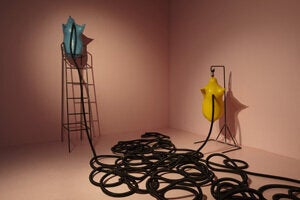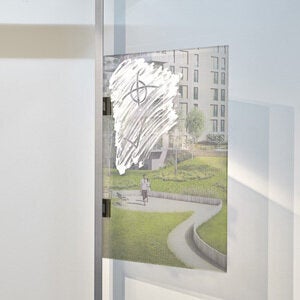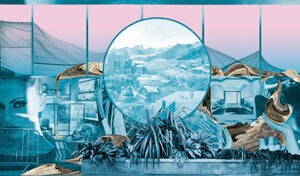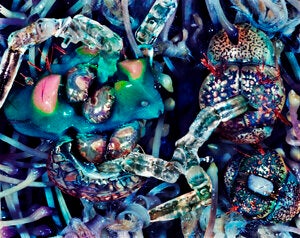It's Catlin Art Prize time again - the annual exhibition of the shortlisted candidates from the Art Catlin Guide featuring the most exciting new art graduates in the UK. Eight finalists this year have been given space at the Londonewcastle Project Space in London in which to develop themes explored during their art school years.

The work of Zhu Tian (Royal College of Art), for example, greets visitors with installations in two rooms and a corridor in which, at random intervals, a steel roller shutter comes down to the accompaniment of classical music. The sense of entrapment engendered is part of an exploration of power relationships. In Dirty (above), Tian develops a narrative based upon French writer Georges Bataille's book about the sexual perversions of two teenage lovers, Story of the Eye. The deliberately ambiguous semi-figure-like objects (the idea for which she derived from Chinese sheepskin floating rafts) are connected with "alien" hoses playfully contained in soft pink. It makes for an arresting introduction to the show.

Another book, Josef Conrad's Heart of Darkness inspired Nicholas William Johnson (Royal College of Art) for his highly colourful Plant of Many Faces (above). What at first appears to be paintings of flowers and undergrowth, on closer examination reveals something more sinister just as Conrad's colonialist became subsumed by an alien culture. Faces and eyes appear, suggestive of dark forces such as the surveillance society perhaps. Foliage is sprouting from mouths, symbols of decay predominate. Johnson's paintings are partly camouflaged by being placed on floral construction site-type hoardings.
This is a theme that permeates this exhibition. As Catlin Prize curator, Justin Hammond, tells me, these hoardings "use this quixotic language of opulence and aspiration and a lot of the artists have tapped into that especially the ones that have to move around from studio to studio having been turfed out."

In Oliver Hickmet's (City and Guilds of London Art School) Are We Nearly There Yet? (above) the artist has collaged images from hoardings that advertise leisure and holiday destinations. Cleverly, he has printed them in such a way that the image disappears when you move behind it. As a result, the metaphor becomes apparent - that you can see through the fantasy, an attempt at what Hickmet sees as a kind of social engineering. His reaction is to smear paint on it, aping the way windows are smeared when they are empty.

Felicity Hammond (Royal College of Art) takes up a similar theme in Capital Growth (above). Again, extreme images of lifestyle success have been collaged together with a central image of economic desolation. The idea she aims to invoke is, as she puts it, "like buying a beautiful property but discovering that the one you've bought hasn't been built yet." Blue is a recurrent colour in Hammond's work. It exemplifies for her the paradox between the blue that's utopian and calming and the blue that, in technology, evokes the error report and the so-called blue screen of death.
The increasing disparities of wealth in this country where the "good life" is but a fantasy to most people serves as a clear backdrop to the imagination of many of these young artists.

The politics of greed is hinted at in Paul Schneider's (Royal Academy of Arts) Bending the Rules (above). Influenced by American artist Sol LeWitt's wall drawings, he has come up with various sports courts which mock the lack of space such surfaces are given on council estates and so on by having them extending up the walls. "It's like giving a lodger a tiny room, or winning the lottery but still not having enough for what you want," he says. The work is simple, clean and humorous and it works.
In an adjoining cubby-hole, Dominic Watson (The Glasgow School of Art) has constructed a wardrobe in which mannequins sport leather jackets, Lowbrow Ecstasy. These are emblazoned not with the macho slogans normally associated with biker culture, but with images from the lowbrow romantic fiction of Mills and Boon. This is a highly personal installation reflecting the changeable nature of male identity. It also is a statement about how commercialism can undermine symbols of counter-culture and examines Watson's own relationship with making art that's somehow consumable.

Male identity is also a theme occupying Jon Baker (Chelsea College of Arts). "I'm very interested in power, masculinity, sex, displays in nature, colours that are used to attract or repel," he says. He has photographed organic material and blown it up so that they resemble parts of the human body, around which he has constructed various objects from plastic and included them in the vividly colourful and positively glistening photographic collage, Mother's Medal (Kink) (above). The title is inspired by the Mother's Cross of Honour, a medal awarded by the Nazis to German women who they saw as advocating the virtues of motherhood and upholding Nazi ideals. Baker says that though the male sexual drive is something he enjoys, he warns against its use as a form of power.

Another highly personal exhibit, and the one I found most intriguing was Lexi Strauss's (Royal College of Art) 1000 Foundlings Find Their Mothers (above). In a theatrical installation housed in a darkened sub-room, various surreal activities take place. An animated dog centred in a nativity scene tells a story, a giant robin sits next to a man while the philosopher Heidegger enjoys a carousel ride with none other than Kate Bush. The last represents archetypes of the artist herself - a mixture of control and free-spiritedness. The theme of the installation questions how people who have received inadequate parenting can adequately parent themselves. It's embodied in the form of the foundling. Two receptacles for placing unwanted babies including a modern "babyklappe" from Germany, on the left of the picture, are included. Strauss's paternal grandparents were Holocaust survivors and a Thomas the Tank engine-type bulldozer is depicted clearing bodies from Belsen and there's a dog with a Hitler moustache. Though some of this humour didn't quite gel with me, a sombre audio narration and mournful songs accentuate a chilling atmosphere.
The exhibition runs at the Londonewcastle Space, 28 Redchurch Street, London E2 7DP until 30 May 2015. The winner, who will receive £5,000, will be chosen by a panel of experts this coming Wednesday.
All images are courtesy of Tom Carter except for Capital Growth which is courtesy of Felicity Hammond.